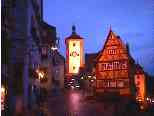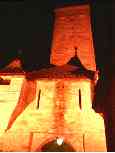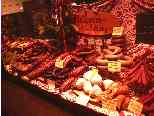I didn't hear the trains as much, but they still interfered with my sleep. As dawn approached, it occurred to me that, if the weather had cleared, I could get up early, scoot up to the castle, and snap a panorama. The window revealed more gray clouds, though. What a relief! I can take my time getting prepared for breakfast...
Another German breakfast, and we're back on the bus. South, to Rothenburg, passing the huge, new glass terminal building at Frankfurt airport along the way.
We grab our bags and follow Gene into the light rain (at least it's
not a cold rain). Brig and I get an excellent room in the Gasthaus
Raidel. Room #1 has a large bed, a shower, washbasin, and toilet.
This is either payback for the Bacharach train observatory, or we are going
to be getting a lousy room in Reutte... Better be nice to Rick, who
does the room assignments. Here's a view from our window. 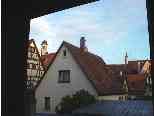 Oh, okay, click here for the real
view. Ah, the magic of digital photography...
Oh, okay, click here for the real
view. Ah, the magic of digital photography...
On our own for the afternoon, we decide to tackle the Kriminalmuseum first. Gruesome, but interesting. The usual truth extraction instruments were there: rack (with optional spiked roller attachment); thumb screws of various designs; chopping blocks and axes, suitable for head removal... They also have a couple of iron maidens, which may not have been designed for capital punishment. According to the accompanying sign, they were used for incarceration, and spikes may have been added to them, for effect, in the 19th century. Logs of executions, from the 15th and 16th centuries, indicate around one execution per year, on average, for an area with 15 to 20,000 inhabitants.
A new (to me) punishment instrument was the "sitting horse." This is a rather simple device, consisting of a sawhorse or other supported plank, with a wedge shape at the top. The miscreant sits astride this puppy (presumably sans cup), and if that's not enough, his legs are weighted down.
The most interesting collection, to my taste, were the humiliation masks. These were strapped on and worn, as punishment, by drunks, gossips, and "wild" men (who failed to restrain themselves adequately). Very fanciful. The gossip's mask is my favorite: huge ears (hears all), big eyeglasses (sees all), and a large tongue (tells all).
We split a quick "kabap" lunch, across from the Raidel. This is a flat bread, filled with shwarma, lettuce, tomato, onion, pepper, and tahini. DM8 with a can of Sprite.
Next, we search for (and after half an hour of trooping around in the rain, finally find) the stairs up to the medieval wall. By the time we arrive, we're pretty well soaked. Happily, the sentry walk is covered. It makes for a nice walk "outdoors," while avoiding further adverse weather. It hadn't occurred to me that views of the outside would be limited to a narrow slot every 10 meters or so. Of course, if you are a sentry, you probably don't want to be seen so easily.
Then we head for St. Jacob's Church. Along the way, we stop in a shop to buy some souvenirs -- Swiss Army knives and a couple of Beany Baby pigs for Brig. Not at the shop recommended in the tour guide, though -- 10% off a 15% markup is no bargain. We also visit a seemingly endless Christmas store. Yikes. And there are two other such stores in town.
At St. Jacob's Church, we study the fabulous wood altar sculpture (circa 1566), carved by Reimenschneider. It's intricately carved from a single block of wood, and includes some amazing, graceful woven wood. Below, the scene is the last supper. Only Judas is carved from a separate piece. After much inspection with our binoculars, we find that Judas is the apostle facing Christ, having just received a piece of bread from him. (A photo on the wall to the left shows the sculpture with Judas removed.) Above the last supper is the raison d'être for this sculpture: a reliquary crucifix. Embedded in the quartz stone at the center of the crucifix, there is supposedly a capsule containing some of Christ's blood. (Not just communion wine?)
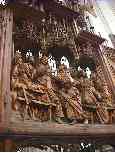
The last supper. Notice Judas, facing Christ |
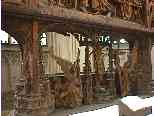
Angels among the woven wood |
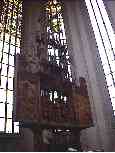
An overview of the carving |
We meet for dinner at the Goldene Rose's restaurant:
- a pleasant (and not oversalted) cream of cauliflower soup
- schnitzel (pork? veal? Does it matter? It's a thin cut of boneless meat, breaded and fried. Feh.)
- string beans, seasoned with bacon (and cooked to European standards of doneness)
- peeled, boiled potatoes.
- a cup of (canned) fruit cocktail with some whipped cream on it. Dessert like mother used to make. Without the whipped cream, that is.
Well executed, no doubt. I ate it all, but it's not my preferred cuisine. The kebap was tastier, a better value, and possibly healthier.
Along the walk to the Castle Garden, just past Hell (chill out, it's just a pub, a little ways down from the Kriminalmuseum), there is a wonderful view of the Tauber River valley and the southern walls. An eerie fog bank was moving around in the valley, periodically moving in and covering the southern walls. Then it would withdraw, and you could see the lights in the valley. It was magical. (Too magical for our camera to capture, though -- sorry.)
A few miscellaneous shots of Rothenburg:
For a real dessert, Brig and I share an ice cream cone: hazelnut,
pistachio, and strawberry. Germany has good ice cream. Oh,
and I eat most of a plum tart we had purchased earlier. Very nice:
cakelike crust; thin layer of pastry cream; topped thickly with quartered
prune plums.
